Ant Exterminator
Ant Exterminator
One of the most common household pests are ants. But here in Alabama, you don’t only need to worry about ants as a household problem. You also have to worry about the biting and stinging variety that makes their homes in your gardens and lawn. If you’ve ever lingered unknowingly in the path of a fire ant, you understand why. Their bite and sting cause an initial pain followed by itching that can last for days. If you find crazy ants in your yard or house, you need to call us immediately for a qualified ant exterminator. These ants can destroy houses and crops. They need to be taken care of immediately.

If you have an ant exterminator problem, you are probably determined to get rid of it, but before you begin you should first confirm whether your problems is, in fact, an ant problem rather than a termite problem. This is sometimes difficult as both insects look similar. There are, however, distinct differences between the two.
When you look at an ant, you will see an insect with a segmented body, two sets of wings—a larger set of front wings and a smaller second set of back wings—and a set of antennas that are bent. When you look at a termite, you will notice a fluent body with two sets of equal length wings and fairly straight antennas.
After you have determined that your infestation is, in fact, ants, you need to determine what species of ant you will be fighting. This is important because the treatments for certain species varies.
Ant Species Found in Alabama
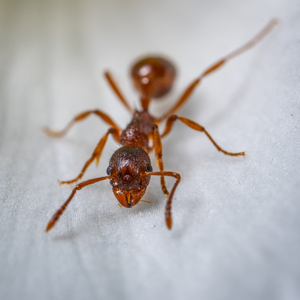
Fire Ants
Found in dirt mounds in the garden, lawn, and near building foundations, these red ¼” inch ants both bite from their jaws while stinging from their abdomen and are aggressive enough that they will sting their victim several times. If stung by a fire ant, a welt will form followed by a white blister.Carpenter Ants: Like termites, carpenter ants destroy wood, chewing on it to make their home then depositing it outside the colony entrances. While they tend to be outdoor ants, they will sometimes make their way into your home and build their nests by chewing on the wood causing damage to your home. Carpenter ants are red to black and grow to be ½” long.
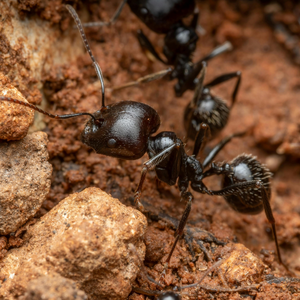
Carpenter Ants
Like termites, carpenter ants destroy wood, chewing on it to make their home then depositing it outside the colony entrances. While they tend to be outdoor ants, they will sometimes make their way into your home and build their nests by chewing on the wood causing damage to your home. Carpenter ants are red to black and grow to be ½” long.
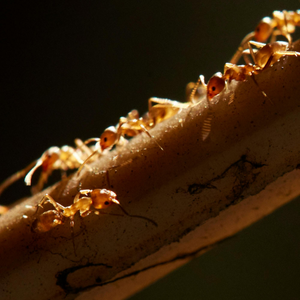
Pharaoh Ants
These yellow or gold ants are a smaller variety only growing to be 1/16” long and have black markings on their backs. They make their way into buildings to avoid the cold.Grease Ants: Similar to the pharaoh ant, a grease ant is often yellow, but they can also be tan or dark brown. The 1/16 -1/12” ants are generally seen in the warmer summer months and nest hidden in the walls and crevices of your home.
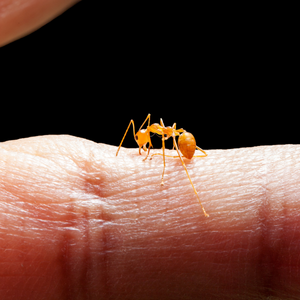
Grease Ants
Similar to the pharaoh ant, a grease ant is often yellow, but they can also be tan or dark brown. The 1/16 -1/12” ants are generally seen in the warmer summer months and nest hidden in the walls and crevices of your home.
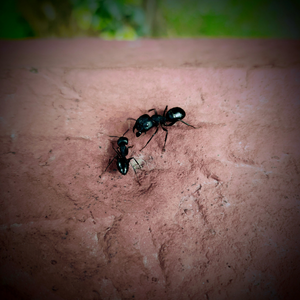
Black Ants
Although called black ants, they can also be dark brown. Approximately 1/8” long, these ants feed on sugary foods, meats, vegetables, and other bugs and can be found making their colonies in both your home and outside in the soil.Crazy Ants: Dark brown or black ants that are 1/10” long and can be seen moving frantically. They are comfortable both inside and outside and tend to like electricity. Crazy ants gather near electrical sources, and upon electrocution, they send off a pheromone that calls to other crazy ants to come to their defense. Those ants are further electrocuted creating a pile of dead ants near the source.
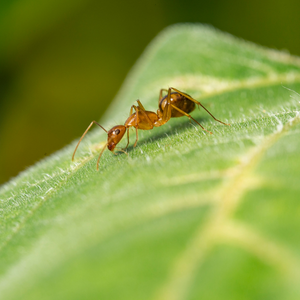
Crazy Ants
Dark brown or black ants that are 1/10” long and can be seen moving frantically. They are comfortable both inside and outside and tend to like electricity. Crazy ants gather near electrical sources, and upon electrocution, they send off a pheromone that calls to other crazy ants to come to their defense. Those ants are further electrocuted creating a pile of dead ants near the source.
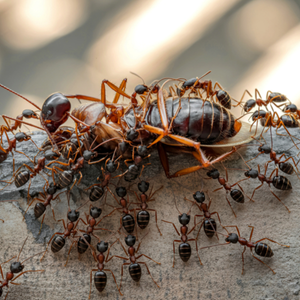
Pavement Ants
Nesting under stones and in sidewalk cracks, you will find the 1/10” black or brown pavement ant. Generally, these are outside ants, but they will enter your home looking for food and water.

Sugar Ants
Ants that don’t bite, regardless of their species, are generally referred to as sugar ants.Pavement Ants: Nesting under stones and in sidewalk cracks, you will find the 1/10” black or brown pavement ant. Generally, these are outside ants, but they will enter your home looking for food and water.
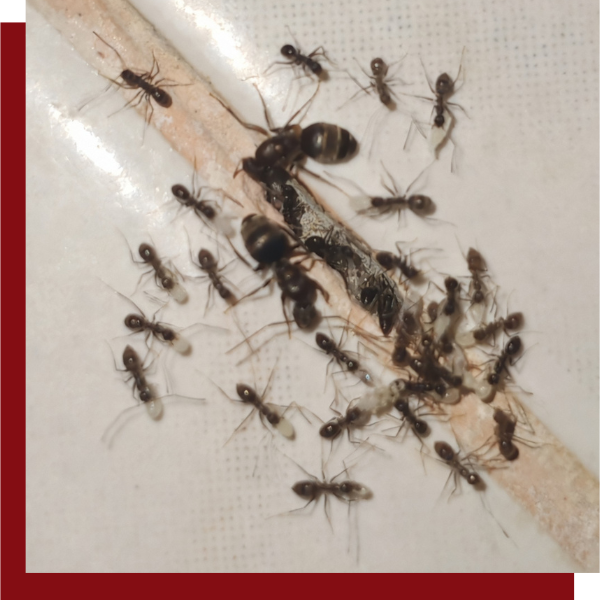
The Hidden Dangers of Ignoring an Ant Infestation
While many homeowners view ants as a mere nuisance interrupting a picnic or invading a sugar bowl, the reality of an infestation is often much more serious. Ignoring the early signs of activity can lead to significant consequences for both your property and your family's health. Species like the carpenter ant are capable of compromising the structural integrity of your home by hollowing out wood for their nests, damage that often goes unnoticed until it is severe. Furthermore, aggressive species such as fire ants pose genuine medical risks; their venomous stings can trigger severe allergic reactions in humans and pets. Professional ant pest control is not just about convenience; it is a necessary step to protect the equity in your home and the safety of your backyard environment from these relentless invaders.
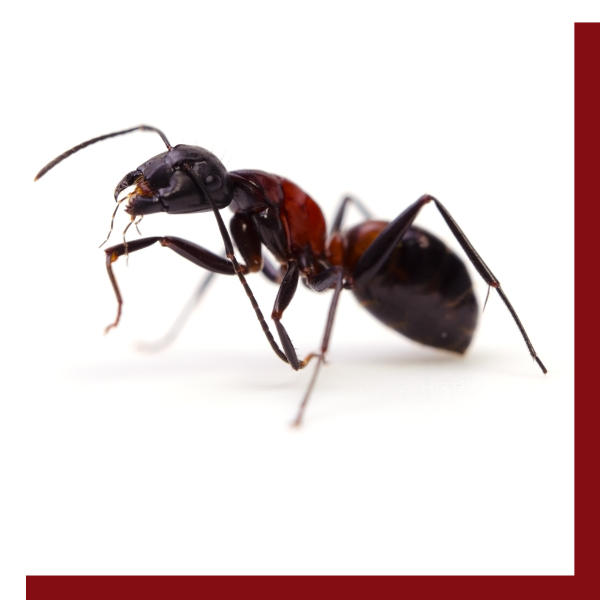
Why DIY Treatments Rarely Solve the Problem
When faced with a line of ants marching across the kitchen counter, the immediate reaction is often to grab a can of bug spray or set out generic bait traps. However, these Do-It-Yourself methods typically offer only temporary relief because they address the symptom rather than the disease. Most consumer-grade sprays only kill the worker ants that are currently visible, leaving the queen and the thousands of developing larvae deep within the colony unharmed. Without a professional ant exterminator to identify the colony's core location and utilize transfer-effect insecticides, the colony will simply replenish its numbers. In many cases, using the wrong type of repellent can actually cause a colony to fracture and split (a process called "budding"), resulting in multiple new infestations spreading throughout your walls and requiring even more extensive pest control services.
Effective Prevention Strategies for Homeowners
Once we have treated your home and eliminated the immediate threat, long-term exclusion is vital to keep ants from returning. Ants are driven by the search for moisture, food, and shelter, and Alabama’s climate provides plenty of all three. By making small changes to your home maintenance routine, you can make your property far less attractive to scouting ants. We recommend implementing the following defense measures:
Seal Entry Points
Inspect the exterior of your home for cracks in the foundation, gaps around utility pipes, and worn weather stripping around doors and windows. Seal these with high-quality silicone caulk.
Manage Vegetation
Keep tree branches and shrubbery trimmed back at least two feet from the side of the house to prevent ants from using them as bridges to your roof or siding.
Moisture Control
Repair any leaking spigots, clear clogged gutters, and ensure your crawl space is properly ventilated, as moisture attracts carpenter ants and other pests.
Sanitation
Store food in airtight containers, clean up spills immediately, and ensure pet food is not left out overnight, as these are primary attractants for foraging scouts.

The Advanced Pest Control Inspection Process
Effective eradication begins with accurate identification and a thorough assessment of the property. Different species require vastly different treatment protocols; what works for a Sugar Ant may be completely ineffective against a Pharaoh Ant. Our process involves a meticulous inspection of both the interior and exterior of your home to locate satellite nests, foraging trails, and high-moisture areas that support colony growth. We look beyond the obvious signs, checking insulation, crawl spaces, and landscape features where colonies thrive. As a dedicated ant exterminator, our goal is to map out the entire infestation network. This diagnostic approach allows us to formulate a customized treatment plan that targets the specific biology and behavior of the invading species, ensuring that we eliminate the infestation at its source rather than just managing the visible population.

The Advantage of a Gulf Shores Exterminator
Coastal Alabama presents a unique set of challenges when it comes to pest management. The high humidity, sandy soil, and mild winters create a perfect breeding ground for ants year-round, unlike in cooler climates where pests go dormant. Choosing a local Gulf Shores exterminator means hiring a team that understands these specific environmental factors and the seasonal behaviors of local ant species. We know exactly when fire ants are most active and how heavy rains can drive outdoor pests into your living spaces. By utilizing pest control services rooted in local experience, you get a defense strategy tailored to the Gulf Coast environment. We are committed to providing our neighbors with reliable, safe, and effective solutions that stand up to the specific demands of our local ecosystem.
Because ants build colonies that can be populated by thousands, a single ant is a sign of many more. While most ants are sterile, a single queen can produce thousands in her lifetime creating frustration for homeowners. If you want to rid your home and yard of ants, contact Advanced Pest Control of Alabama, so we can identify the ant species and safely treat the infestation with the right insecticide.
